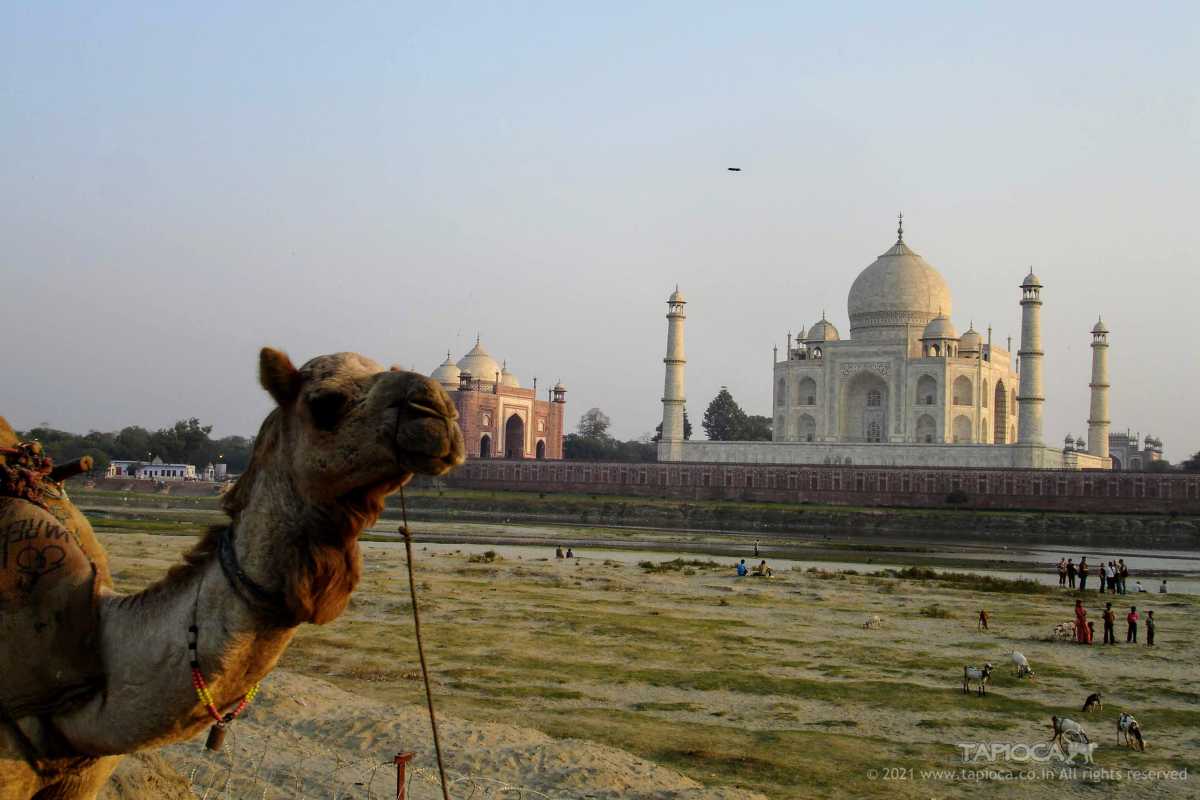Taj Mahal

The less viewed side of Taj
Taj Mahal viewed from the other side of Yamuna River
C
onsidered as one among the beautiful buildings of the world, the Taj Mahal represents true intimacy and is a of eternal love.The name Taj Mahal signifies “crown of buildings” and it stands true to its name. The Taj Mahal was declared an UNESCO World Heritage Site in the year 1983.
“Not Architecture! As all others are,
But the proud passion of an Emperor’s love
Wrought into living stone, which gleams and soars
With body of beauty shining soul and thought;
… As when some face
Divinely fair unveils before our eyes–
Some woman beautiful unspeakably–
And the blood quickens, and the spirit leaps,
And will to worship bends the half-yielded knees,
While breath forgets to breathe. So is the Taj!”
These initial lines by Sir Edwin Arnold speak not just poetry but the love story that lies behind a
world-famous monument, The Taj Mahal!
These lines describe not only the architectural beauty of the monument but the internal thoughts and imagination that the creator Shah Jahan himself would have had.
The Taj Mahal is one of the world’s famous and most photographed mausoleums. A mausoleum is an external free-standing building that encloses a tomb or burial chamber within it. It encloses within it the burial chamber of Mumtaz Mahal, the third wife of the Mughal ruler Shah Jahan. Shah Jahan built this world’s most recognizable structure in memory of his beloved wife when she died during the birth of their 14th child.
The monument was built 22 years after her death and her remains were re-buried inside the monument in a memorable fashion.
After the death of Shah Jahan, he was also buried along his wife inside the Taj Mahal by his Aurangazeb. The garden along the pathway and the domed structure on the riverside is a pleasure to watch irrespective of the season and time of the day. The building is a perfect example of Mughal Architecture which is a blend of Indian, Islamic and Persian styles of architecture.
Construction
The death of his wife, Mumtaz Mahal shattered the emperor Shah Jahan and the concept for creation of a memorial emerged during these periods. It is also said that Mumtaz in her deathbed asked Shah Jahan to build a memorial for their love that the world will look upon forever. Started in 1632, the beautiful Taj Mahal was completed in 1653 with thousands of skilled artisans and craftsmen working on its construction. The mausoleum was created by
many architects based on the principal design of Ustad Ahmad Lahauri.
Other notable architects of the period who were involved were Makramat Khan and Abdul ul- Karim Ma’mur Khan. It is also believed that the Italian designer Geronimo Verroneo also submitted many designs to the emperor Shah Jahan for the basic construction of the Taj Mahal. The principal building structure was finished by about 1648 though completion of the entire mausoleum took another 5 years.
The “feminine touch” in the Taj Mahal Did you know that the Taj Mahal was meant to be made feminine in nature? It was supposed to be a depiction of Mumtaz Mahal itself shining bright along the river side reflecting the moods of the day.
The beauty of the monument is a direct relation to the beauty of the woman who lies within. The concept exhibited by the architect is symbolical to the grace and beauty of the Mughal queen. It is designed as a tribute of the Mughal Ruler to the Indian womanhood.
Architecture
The masterminds that created the Taj Mahal was not restricted to any single sect or individual, but was the concentrated effort of many great artistic minds. Mughal court has always been a core point for artistic talents from all parts of the world. The utilization of every possible resources available and the huge time and money spent on the monument was an consolidated effort to make the Taj Mahal one of the wonders of the world. It is said that Shah Jahan wanted the whole world to admire his monument built to express his love and grief.
The total amount spent on the construction of the Taj Mahal is estimated by the local natives of Agra to be around 185 Lakhs. The sarcophagus was initially surrounded by a screen or fence made of gold studded with gems. The Taj also contained silver decorated doors, rich Persian silk carpets, decorated candlesticks and golden lamps that further enhanced the beauty. A sheet of pearls was also ordered to be made by Shah Jahan to cover the sarcophagus. Most of these wealth possessed by the Taj was melted or looted down the ages though the beauty never diminished.
The Taj Mahal is an example of Persian, Indian and Mughal architecture. It is the highest example of architectural talent of the Mughal emperor Shah Jahan. The building style of the Taj Mahal was an inspiration from many previous Timurid and Mughal architectures like the Gur-e-Amir, Humayun’s Tomb and the Jama Masjid. One can also find a resemblance of the Taj Mahal with the Itmad-Ud-Daulah’s Tomb which is also known as ‘baby Taj’. Though most of the earlier Mughal architectures involved design and construction using red sandstone,
the use of white marble and semi-precious jewels is an added speciality of the Taj. The white marble dome is the prime attraction and the most popular representation of the Taj Mahal. The surrounding gardens and the river Yamuna along the sides adds to the beauty of the mausoleum’s construction.
Rumours
There are many stories and tales that surround the Taj Mahal regarding the construction and many about Shah Jahan’s policy of blinding or killing the artisans and architects. There have always been constant arguments and discussions about the authenticity of the monument as a sect of people believe that it was originally a Hindu temple. Stories also revolve about a secret room inside the Taj which still holds ancient Hindu deities and other sculptures which was removed when the underlying Hindu temple was demolished. It is also a prevalent and very popular legend that Shah Jahan wanted to build a black Taj Mahal for him across the river which he wanted to connect with the Taj by means of a bridge but there are no facts or proofs that have been found to support this.
“If love can do wonders, then this world wonder is the perfect example for it” The history of the Taj Mahal involves not just the monument and its historical importance but also closely integrates the life of the Mughal rulers and the city of Agra. Read on to learn the story of the King and the Queen who lie within the Taj Mahal and about their special love story.
